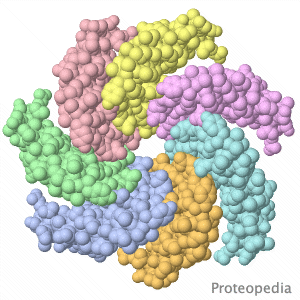Main Page
From Proteopedia
m (Protected "Main Page" [edit=sysop:move=sysop] [cascading]) |
|||
| (29 intermediate revisions not shown.) | |||
| Line 1: | Line 1: | ||
<table id="tableColumnsMainPage" style="width:100%;border:2px solid #ddd;border-collapse: collapse;table-layout: fixed; "> | <table id="tableColumnsMainPage" style="width:100%;border:2px solid #ddd;border-collapse: collapse;table-layout: fixed; "> | ||
| - | <tr><td colspan=' | + | <tr><td colspan='3' style="background:#F5F5FC;border:1px solid #ddd;"> |
<div style="top:+0.2em; font-size:1.2em; padding:5px 5px 5px 10px; float:right;">'''''ISSN 2310-6301'''''</div> | <div style="top:+0.2em; font-size:1.2em; padding:5px 5px 5px 10px; float:right;">'''''ISSN 2310-6301'''''</div> | ||
| - | <span style="border:none; margin:0; padding:0.3em; color:#000; font-style: italic; font-size: 1. | + | <span style="border:none; margin:0; padding:0.3em; color:#000; font-style: italic; font-size: 1.4em;"> |
| - | <b>As life is more than 2D</b>, Proteopedia helps to bridge the | + | <b>As life is more than 2D</b>, Proteopedia helps to bridge the gap between 3D structure & function of biomacromolecules |
| + | </span> | ||
| + | |||
| + | <span style="border:none; margin:0; padding:0.3em; color:#000; font-style: italic; font-size: 1.1em;max-width:80%;display:block;"> | ||
| + | <b>Proteopedia</b> presents this information in a user-friendly way as a '''collaborative & free 3D-encyclopedia of proteins & other biomolecules.''' | ||
</span> | </span> | ||
| Line 11: | Line 15: | ||
<tr> | <tr> | ||
| - | <th style="padding: 10px;background-color: #33ff7b">Selected Pages | + | <th style="padding: 10px;background-color: #33ff7b">Selected Research Pages</th> |
| - | + | <th style="padding: 10px;background-color: #f1b840">In Journals</th> | |
| - | <th style="padding: 10px;background-color: #f1b840">Journals</th> | + | |
<th style="padding: 10px;background-color: #79baff">Education</th> | <th style="padding: 10px;background-color: #79baff">Education</th> | ||
</tr> | </tr> | ||
| - | <tr> | + | <tr valign='top'> |
| - | <td style="padding: | + | <td style="padding: 5px;"> {{Proteopedia:Featured SEL/{{#expr: {{#time:U}} mod {{Proteopedia:Number of SEL articles}}}}}}</td> |
| - | + | ||
<td style="padding: 5px;"> {{Proteopedia:Featured JRN/{{#expr: {{#time:U}} mod {{Proteopedia:Number of JRN articles}}}}}}</td> | <td style="padding: 5px;"> {{Proteopedia:Featured JRN/{{#expr: {{#time:U}} mod {{Proteopedia:Number of JRN articles}}}}}}</td> | ||
<td style="padding: 5px;"> {{Proteopedia:Featured EDU/{{#expr: {{#time:U}} mod {{Proteopedia:Number of EDU articles}}}}}}</td> | <td style="padding: 5px;"> {{Proteopedia:Featured EDU/{{#expr: {{#time:U}} mod {{Proteopedia:Number of EDU articles}}}}}}</td> | ||
| Line 26: | Line 28: | ||
<tr style="font-size: 1.2em; text-align: center;"> | <tr style="font-size: 1.2em; text-align: center;"> | ||
<td style="padding: 10px;background-color: #33ff7b"></td> | <td style="padding: 10px;background-color: #33ff7b"></td> | ||
| - | <td style="padding: 10px;background-color: #dae4d9"></td> | ||
<td style="padding: 10px;background-color: #f1b840"></td> | <td style="padding: 10px;background-color: #f1b840"></td> | ||
<td style="padding: 10px;background-color: #79baff"></td> | <td style="padding: 10px;background-color: #79baff"></td> | ||
| Line 32: | Line 33: | ||
| - | <tr style="font-size: 1. | + | <tr style="font-size: 1.0em; text-align: center;"> |
<td style="padding: 10px;> | <td style="padding: 10px;> | ||
| Line 38: | Line 39: | ||
<p>[[Proteopedia:Video_Guide|Video Guides]]</p> | <p>[[Proteopedia:Video_Guide|Video Guides]]</p> | ||
<p>[[Who knows]] ...</p> | <p>[[Who knows]] ...</p> | ||
| - | </td> | ||
| - | |||
| - | <td style="padding: 10px;> | ||
| - | <p>[[:Category:PDB Art|List of Art on Science pages]]</p> | ||
</td> | </td> | ||
| Line 59: | Line 56: | ||
</tr> | </tr> | ||
| - | <tr><td colspan=' | + | <tr><td colspan='3' > |
<table width='100%' style="padding: 10px; background-color: #d7d8f9; font-size: 1.5em;"><tr> | <table width='100%' style="padding: 10px; background-color: #d7d8f9; font-size: 1.5em;"><tr> | ||
<td>[[Proteopedia:About|About]]</td> | <td>[[Proteopedia:About|About]]</td> | ||
<td>[[Special:Contact|Contact]]</td> | <td>[[Special:Contact|Contact]]</td> | ||
| + | <td>[[Template:MainPageNews|Hot News]]</td> | ||
<td>[[Proteopedia:Table of Contents|Table of Contents]]</td> | <td>[[Proteopedia:Table of Contents|Table of Contents]]</td> | ||
<td>[[Proteopedia:Structure Index|Structure Index]]</td> | <td>[[Proteopedia:Structure Index|Structure Index]]</td> | ||
Current revision
|
ISSN 2310-6301
As life is more than 2D, Proteopedia helps to bridge the gap between 3D structure & function of biomacromolecules Proteopedia presents this information in a user-friendly way as a collaborative & free 3D-encyclopedia of proteins & other biomolecules.
| ||||||||
| Selected Research Pages | In Journals | Education | ||||||
|---|---|---|---|---|---|---|---|---|
|
|
|
||||||
|
How to add content to Proteopedia Who knows ... |
Teaching strategies using Proteopedia |
|||||||
| ||||||||



